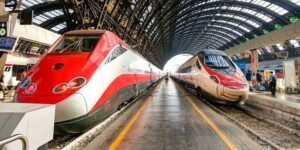India’s First Bullet Train to Start 100-km Run Between Surat and Vapi
|
General Studies Paper II: Government policies and interventions, Groupings & Agreements Involving India |
Why in News?
Recently, India’s Railway Ministry announced that India’s first bullet train will operate a 100-kilometre stretch between Surat and Vapi during its planned inauguration in August 2027, a key step toward integrating Japanese Shinkansen technology and reshaping long-distance mobility across the western corridor.

India’s First Bullet Train Project
- About: India’s first high-speed rail project represents a major technological shift in the country’s transport sector. The government aims to introduce trains that can run at a maximum speed of 320 km per hour, a standard followed by advanced rail systems in Japan and Europe. This high-speed rail project reflects India’s effort to modernize its railway infrastructure by adopting global best practices.
- Project Detail: The bullet train corridor covers a distance of 508 kilometres between Mumbai and Ahmedabad and includes twelve stations such as Mumbai, Thane, Virar, Vapi, Surat, Bharuch, Vadodara, Anand, Ahmedabad and others. A 21-kilometre underground tunnel is being constructed near Mumbai, including a 7-kilometre undersea tunnel, which is the first of its kind in India.
- Background: The idea of introducing bullet trains in India emerged seriously during the early 2010s. The Indian and Japanese governments signed a landmark agreement in December 2015 to develop the project under a long-term partnership model. The National High-Speed Rail Corporation Limited (NHSRCL) was established in 2016 to implement the corridor and coordinate planning, land acquisition, and construction. The foundation stone was laid by the Prime Ministers of India and Japan in September 2017.
- Fund: The estimated cost of the project is INR 1,08,000 crore (USD 17 billion). The project follows a unique funding arrangement in which Japan provides around 81% of the total capital requirement through a soft loan. The loan carries an interest rate of 0.1%, a repayment period of 50 years, and a grace period of 15 years, including investment in training facilities, manufacturing units for components, and technology transfer mechanisms.
- Timeline: In 2024, the Railway Minister announced that the first trial run would be conducted on a priority stretch in Gujarat. In 2025 updates indicated that the initial operational section between Surat and Vapi would measure 100 kilometres during the inauguration planned for August 2027.
Features of India’s First Bullet Train Project
- High Operating Speed: The bullet train uses Shinkansen E5 technology, which supports a maximum speed of 320 km per hour. The system is designed to maintain consistent speed even on long stretches, which reduces travel time sharply. The corridor aims to cut the Mumbai–Ahmedabad journey from nearly six hours to about two hours.
- Advanced Safety Systems: The project follows Japan’s globally recognized zero-fatality safety record for high-speed rail. It includes Automatic Train Protection (ATP) and Automatic Train Control (ATC) systems that remove the chance of collision by eliminating driver-based errors. The infrastructure includes earthquake detection sensors that halt the train instantly during seismic activity.
- Dedicated High-Speed Corridor: The Mumbai–Ahmedabad line is built as a fully dedicated track exclusively for bullet trains. This feature ensures uninterrupted movement without mixing with slow or freight trains. The corridor spans 508 km, with long elevated sections that reduce land conflicts and enhance safety. It is a significant engineering feature that ensures seamless alignment.
- Modern Station Infrastructure: All bullet train stations are designed with multimodal integration, which links passengers to metro, bus, and local transport systems. Stations include barrier-free access for senior citizens and persons with disabilities. The architecture focuses on fast movement through wide concourses, advanced ticketing, and automated gates.
- Energy-Efficient Rolling Stock: The train sets use lightweight aluminium alloy bodies that reduce energy consumption. They also include regenerative braking, which converts braking energy into electricity and feeds it back into the power system. The aerodynamic nose design reduces air resistance during high-speed travel.
Significance of India’s First Bullet Train Project
- Economic Growth: The western region contributes heavily to national output. Maharashtra and Gujarat together account for more than 25% of India’s GDP and a significant share of exports. The bullet train corridor strengthens the movement of skilled labour, business travellers, and high-value services. Improved mobility attracts investments in manufacturing and real estate.
- Technology Transfer: The project promotes large-scale technology transfer from Japan’s Shinkansen ecosystem. Under the agreement, India receives support in track construction, rolling stock technology, signalling systems, and earthquake-resistant design. More than 300 Indian engineers have already undergone specialized training in Japan.
- Generates Employment: NHSRCL reports indicate that the project will create over 20,000 construction jobs. Official statements specify that the Mumbai-Ahmedabad High-Speed Rail (MAHSR) project is estimated to generate a total of more than 90,000 direct and indirect jobs during the construction phase. The corridor supports Make in India by encouraging domestic production.
- Boost to Foreign Investment: The successful implementation of this project is expected to attract more foreign investment in high-speed rail and other large-scale infrastructure projects. Opening doors for more foreign investment in the rail sector, where 100% Foreign Direct Investment (FDI) is already permitted in certain areas.
- India–Japan Ties: Japan is funding the project cost through a long-term loan, it reflects a strong strategic alignment in infrastructure development. The cooperation promotes deeper ties in technology, engineering, and economic policy. This is the strongest symbol of India–Japan partnership after the Delhi Metro project.
|
Shinkansen E5 Technology
|
|
Also Read: India–Bhutan Special Railway Project |









